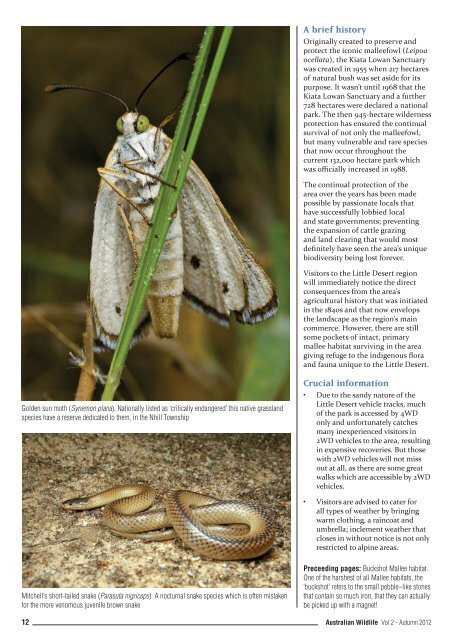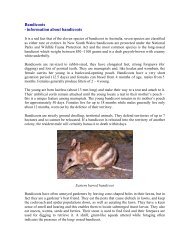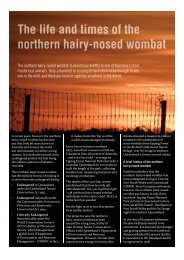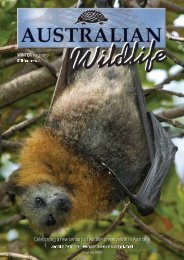Wildlife Preservation Autumn 2012.indd - Wildlife Protection Society ...
Wildlife Preservation Autumn 2012.indd - Wildlife Protection Society ...
Wildlife Preservation Autumn 2012.indd - Wildlife Protection Society ...
Create successful ePaper yourself
Turn your PDF publications into a flip-book with our unique Google optimized e-Paper software.
Golden sun moth (Synemon plana). Nationally listed as ‘critically endangered’ this native grassland<br />
species have a reserve dedicated to them, in the Nhill Township<br />
Mitchell’s short-tailed snake (Parasuta nigriceps). A nocturnal snake species which is often mistaken<br />
for the more venomous juvenile brown snake<br />
A brief history<br />
Originally created to preserve and<br />
protect the iconic malleefowl (Leipoa<br />
ocellata), the Kiata Lowan Sanctuary<br />
was created in 1955 when 217 hectares<br />
of natural bush was set aside for its<br />
purpose. It wasn’t until 1968 that the<br />
Kiata Lowan Sanctuary and a further<br />
728 hectares were declared a national<br />
park. The then 945-hectare wilderness<br />
protection has ensured the continual<br />
survival of not only the malleefowl,<br />
but many vulnerable and rare species<br />
that now occur throughout the<br />
current 132,000 hectare park which<br />
was o cially increased in 1988.<br />
The continual protection of the<br />
area over the years has been made<br />
possible by passionate locals that<br />
have successfully lobbied local<br />
and state governments; preventing<br />
the expansion of cattle grazing<br />
and land clearing that would most<br />
de nitely have seen the area’s unique<br />
biodiversity being lost forever.<br />
Visitors to the Little Desert region<br />
will immediately notice the direct<br />
consequences from the area’s<br />
agricultural history that was initiated<br />
in the 1840s and that now envelops<br />
the landscape as the region’s main<br />
commerce. However, there are still<br />
some pockets of intact, primary<br />
mallee habitat surviving in the area<br />
giving refuge to the indigenous ora<br />
and fauna unique to the Little Desert.<br />
Crucial information<br />
• Due to the sandy nature of the<br />
Little Desert vehicle tracks, much<br />
of the park is accessed by 4WD<br />
only and unfortunately catches<br />
many inexperienced visitors in<br />
2WD vehicles to the area, resulting<br />
in expensive recoveries. But those<br />
with 2WD vehicles will not miss<br />
out at all, as there are some great<br />
walks which are accessible by 2WD<br />
vehicles.<br />
• Visitors are advised to cater for<br />
all types of weather by bringing<br />
warm clothing, a raincoat and<br />
umbrella; inclement weather that<br />
closes in without notice is not only<br />
restricted to alpine areas.<br />
Preceeding pages: Buckshot Mallee habitat.<br />
One of the harshest of all Mallee habitats, the<br />
‘buckshot’ refers to the small pebble–like stones<br />
that contain so much iron, that they can actually<br />
be picked up with a magnet!<br />
12 Australian <strong>Wildlife</strong> Vol 2 - <strong>Autumn</strong> 2012





